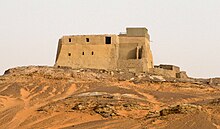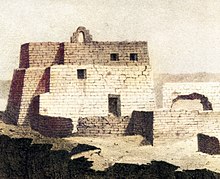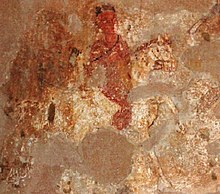Dunqula Throne Hall
The Dunqula Throne Hall (English: Throne Hall of Dongola , Mosque Building ) is a monument in Old Dunqula , Sudan . The two-story brick building is located on a stony hill above the city and the Nile valley. It was originally built in the 9th century and was the ornate representative building of the Makurian kings. In 1317, during the decline of the Makurian Empire, it was rebuilt and used as a mosque until it was closed in 1969 and made a historical monument. Shortly afterwards, Polish archaeologists began to examine and excavate the building. It is considered to be the "most important, symbolic building in the medieval history of Sudan" and is currently the oldest surviving mosque in Sudan.
history
Throne Hall of Makuria (9th century -1317)
From the late 5th century onwards, Alt Dunqula ( Old Nubian : Tungul ) was the capital of the Nubian kingdom of Makuria , which was Christianized in the middle of the 6th century and successfully defended its independence against Islamic expansion in the 7th century. The city experienced a golden age between the 9th and 11th centuries . Several representative buildings were erected in the 9th century, including the throne hall. It was probably built in the first half of the 9th century, during the reign of Giorgios I (835-887) and his father Zakharias II (835-857). The palace was built on a rock in the eastern part of the city. From this prominent position, the two-story building offered a wide view of the city and the Nile . Its purpose has been interpreted differently over the years and described as a church, monastery and royal castle. However, its design conveys that it had official purposes and was not used as a residence, but that it was primarily intended to impress visitors. The throne hall was on the upper floor, to which the official delegations and processions reached via a monumental staircase. Both the throne hall and the stairwell were decorated with wall paintings. These were in the 11th – 12th Century modified.
From 1265 Makuria suffered repeated attacks by the Mameluke Sultanate , which from 1276 usually put a puppet king on the throne of Makuria. At the end of the 13th century, after another severe confrontation with the Mamluken , the most important buildings of Old Dunqula were in ruins, including the throne hall, and the population had shrunk drastically due to deportations. The south and north-west sides of the throne hall were particularly hard hit. Soon after the destruction, at the turn of the 13th century, the building was refurbished and made numerous changes.
Mosque (1317–1969)
In 1316 the Mamluks interfered again in Makuria politics. They tried to bring Barschanbu to the throne. Unlike the kings before him, he was a Muslim . On May 29, 1317, he turned the throne hall into a mosque, as evidenced by a marble inscription. Changes to the building, especially in the central hall on the upper floor, were made in accordance with the new function. A mihrab was installed and the Christian wall paintings were plastered over. Barschanbu was not popular because of his demeanor and reforms. The nubiologist Wlodziemierz Godlewski suspects that the transformation of the throne hall contributed to its demise. Barschanbu was murdered by his own followers that same year. After his death, Makuria was ruled by both Muslim and Christian kings. However, none of them dared to restore the building to its original function, as the Mamluk sultans protected the new function.
A civil war caused the destruction of Alt Dunqula in 1365. The Makurier kings fled to Lower Nubia in the north, where they were able to hold out for another 150 years. Old Dunqula, abandoned by the Makuria, came under the control of the Arab Banu Ja'd and a new political entity emerged, the so-called Kingdom of Dunqula City . This was taken by the Funj Sultanate in the early 16th century . Records show that the building was used as a shelter for Mecca pilgrims . However, in the 17th to 19th centuries, the ground floor was probably no longer accessible. In the second half of the 18th century, a local sheikh , Sati Hamid Sawar , carried out extensive renovations.
From the early 19th century, the building was repeatedly described by Western travelers and explorers. In the late 19th century, Old Dunqula was abandoned, but the mosque remained in use. It was first extensively documented in 1906. A year later it was again extensively restored by Ahmed Helmi , Naib des Mamur of Debba ; several other restorations were carried out by the Sudan Antiquities Service and various museums from the mid-20th century. Its use as a religious building was abandoned in 1969, but it was preserved as the oldest surviving mosque in Sudan.
Historic building (from 1969)
After rescue excavations at Faras Cathedral , Polish archaeologists turned to Alt Dunqula, where they began excavations in 1964. Between 1970 and 1983 they excavated the throne hall and documented architecture and wall paintings.
Old Dunqula is to be converted into an archaeological park. The construction of a steel roof structure is planned to provide weather protection and to offer a stabilizing framework. After examining the wall paintings in the stairwell and the main hall on the first floor, theories about iconography and chronology were put forward. From 2018 to 2023, Alt Dunqula will be the subject of a large, multidisciplinary project to study the changes between the 14th and early 19th centuries.
architecture
The throne hall was influenced by Byzantine architecture and thus gives a clear indication of the connection between Makuria and the Byzantine Empire . Comparable reception rooms are also known from the First Bulgarian Empire (ц︢рьство бл︢гарское). They imitate the representative architecture of Constantinople , albeit in smaller dimensions . The throne hall is 12 m high, 28 m long and 18 m wide. It is made of mud bricks, as well as red burnt bricks and sandstone.
Murals
The murals in the hall are damaged by plastering, rainwater, termites and bats. They are located in the stairwell and in the great hall and show influences from Byzantine models. The walls of the stairwell had two layers of painted plaster with pictures of Archangel Michael with a spear, two warrior saints (one on foot and one on horseback), and several unidentifiable standing figures.
The hall also had numerous layers of painted plaster, but with different layers depending on the wall. The east wall had a large nativity scene with the Virgin Mary on a mat, a nativity scene with the Christ Child , angels and, on the left, the Magi . The color scheme is limited to yellow, orange, red, and purple tones. The eastern part of the south wall shows a fragmentary representation of the Archangel Michael and the Trinity , while the western part was divided into two scenes; one of them showed Mary holding the Christ Child while she stretched out for a palm tree. Again, the colors are limited to purple, yellow and red. The iconography of this last scene is unique in the context of the Makurian Empire. The other scene on the western half originally showed the transfiguration , but was later painted over with a representation of the Trinity and a barely preserved king with a horned crown. On the west wall there is a king with a scepter and a Byzantine crown and two standing figures with a halo . The north wall bears a large cross, a priest and a king with a crown, a blue veil and a white robe. A later shift had added the twenty-four elders from Revelation , with white robes and palm leaves in their hands as they sat on thrones.
See also
Individual evidence
- ^ "The most important, symbolic edifice in the medieval history of Sudan". Obłuski, Godlewski, Kołątaj, Medeksza 2013: 248.
- ↑ Godlewski 2013: 7.
- ^ Welsby 2002: 68-70.
- ↑ Godlewski 2013: 11-12.
- ↑ a b Obłuski, Godlewski, Kołątaj, Medeksza 2013: 252.
- ↑ Zakharias II had conquered the throne in 835. In the same year he crowned his son Georgios I as king before sending him on a diplomatic mission to Baghdad , possibly to increase his prestige. After the death of Zakharias in 857, his son became the sole ruler. Werner 2013: 89-92.
- ↑ a b c d e Godlewski 2013: 12.
- ↑ Obłuski, Godlewski, Kołątaj, Medeksza 2013: 257th
- ↑ a b Godlewski 2013: 47.
- ^ Godlewski 2013: 43.
- ^ Welsby 2002: 243-247.
- ^ Godlewski 2013: 135.
- ↑ Obłuski, Godlewski, Kołątaj, Medeksza 2013: 252; Godlewski 2013: 135
- ↑ Hasan 1967: 118-119
- ↑ a b Werner 2013: 138.
- ↑ a b c d Godlewski 2013: 137.
- ^ Welsby 2002: 247.
- ↑ Werner 2013: 138–141.
- ↑ Werner 2013: 143-145.
- ^ Godlewski 2013: 135.
- ↑ O'Fahey Spaulding 1974: 26-28.
- ↑ Obłuski, Godlewski, Kołątaj, Medeksza: The Mosque Building in Old Dongola. Conservation and revitalization project. In: Polish Archeology in the Mediterranean 2013: 263.
- ↑ Obłuski, Godlewski, Kołątaj, Medeksza 2013: 250.
- ↑ a b Godlewski 2013: 13.
- ↑ Obłuski, Godlewski, Kołątaj, Medeksza 2013: 263.
- ↑ a b Obłuski, Godlewski, Kołątaj, Medeksza 2013: 248.
- ↑ Godlewski 2013: 14.
- ↑ Obłuski, Godlewski, Kołątaj, Medeksza 2013: 251.
- ↑ Tarczewski, Dziedzic 2015: 230–231.
- ↑ Cordis 2017.
- ^ Godlewski 2013: 43.
- ↑ Obłuski, Godlewski, Kołątaj, Medeksza 2013: 257th
- Jump up ↑ Obłuski, Godlewski, Kołątaj, Medeksza 2013: 270.
- ↑ Obłuski, Godlewski, Kołątaj, Medeksza 2013: 257, 259.
- ↑ Zielinska 2015: 25.
- ↑ Zielinska 2015: 26–27.
- ↑ Zielinska 2015: 29–30.
- ^ Godlewski 2013: 45.
- ↑ Zielinska 2015: 30–31.
- ↑ Zielinska 2015: 33–35.
literature
- CORDIS: Urban Metamorphosis of the community of a Medieval African capital city . In: CORDIS . October 31, 2017.
- Włodzimierz Godlewski: Dongola-ancient Tungul. Archaeological guide . Polish Center of Mediterranean Archeology, University of Warsaw, 2013, ISBN 978-83-903796-6-1 .
- Yusuf Fadl Hasan: The Arabs and the Sudan. From the seventh to the early sixteenth century . Edinburgh University, 1967, OCLC 33206034 .
- Artur Obłuski, Włodzimierz Godlewski, Wojciech Kołątaj, Stanisław Medeksza: The Mosque Building in Old Dongola. Conservation and revitalization project. In: Polish Center of Mediterranean Archeology. University of Warsaw : Polish Archeology in the Mediterranean. 2013, vol. 22: 248-272. ISSN 2083-537X
- RS O'Fahey, Jay L. Spaulding: Kingdoms of the Sudan . Methuen Young Books, 1974, ISBN 978-0416774504 .
- Romuald Tarczewski, Teresa Dziedzic: Dongola Site Presentation Project: Progress in the 2013 Season. In: Włodzimierz Godlewski, Dorota Dzierzbicka (ed.): Dongola 2012-2014. Fieldwork, conservation and site management. Polish Center of Mediterranean Archeology, University of Warsaw 2015: 325–331. ISBN 978-83-903796-8-5
- Derek Welsby: The Medieval Kingdoms of Nubia. Pagans, Christians and Muslims Along the Middle Nile . British Museum, 2002, ISBN 978-0714119472 .
- Roland Werner : Christianity in Nubia. History and shape of an African church. Lit 2013. ISBN 978-3-643-12196-7
- Dobrochna Zielinska: Painted decoration of the Central Hall: preliminary inventory. In: Włodzimierz Godlewski, Dorota Dzierzbicka (ed.): Dongola 2012-2014. Fieldwork, conservation and site management. Polish Center of Mediterranean Archeology, University of Warsaw 2015: 325–331. ISBN 978-83-903796-8-5 [1]
Coordinates: 18 ° 13 ′ 29 ″ N , 30 ° 44 ′ 44 ″ E



